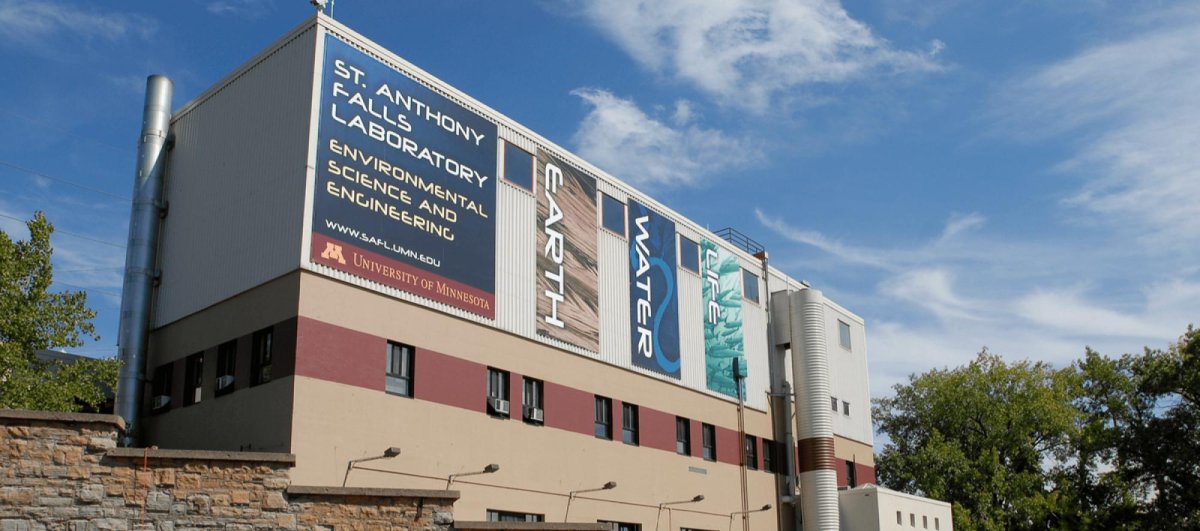Renovation Grant Propels SAFL forward

In September 2010, the National Science Foundation awarded St. Anthony Falls Laboratory (SAFL) a $7.1 million grant to renovate its facility. The grant is awarded via the Academic Research Infrastructure (ARI) program, which is funded under the American Recovery and Reinvestment Act of 2009. ARI supports the repair and renovation of existing research facilities.
In addition, the University of Minnesota will contribute $8.7 million for critical renovation costs not eligible for NSF funding. These funds, part of Minnesota Higher Education Asset Preservation and Replacement (HEAPR), will ensure the renovation brings this Depression-era building in line with modern codes and safety standards. Renovation funds will revitalize the aging laboratory, accelerating SAFL’s transition from its roots in hydraulic structures to a modern, process-oriented laboratory devoted to sustainable energy and Earth-surface environment management and restoration.
Leading the Way in Environmental Engineering and Science
SAFL was founded in 1938 to help provide the know-how for building the nation’s civil water systems based on the engineering standards of the time. By addressing critical building infrastructure issues, this grant will facilitate SAFL’s role in support of sustainable energy and environmental infrastructure and management in the 21st century. SAFL will continue to play an international leadership role in environmental engineering and science.
ARI funding will enable the laboratory to become a state-of-the-art interdisciplinary research and training facility and explore new societal concerns. In particular, SAFL will:
- Adapt existing facilities and expertise in turbulence and the atmospheric boundary layers for wind power optimization.
- Optimize methods for generating sustainable hydrokinetic energy and hydropower with minimal environmental impacts.
- Adapt existing facilities and expertise in fluid-biota interaction for biofuels research focusing on optimization of algal bioreactors for lipid accumulation under variable environmental conditions.
- Enhance the indoor and outdoor laboratory capabilities in environmental restoration and management, including streams, rivers, and deltas.
- Allow researchers, practitioners, and a broad spectrum of learners to experience and participate in SAFL through cyber-collaboration, visualization, and virtual experiments.
Addressing Large-Scale Societal Problems
The renovation will greatly enhance SAFL’s research infrastructure and enable the laboratory to tackle challenging societal problems in several areas of energy and environmental sustainability. Three specific examples are described below.
1. Biofuels Research: Scaling Algal Lipid Production for Bioenergy
Microalgae could be a significant energy source if we could produce algal lipid on a large scale. How can laboratory measurements be scaled on a field bioreactor to enhance lipid production? Using the upgraded SAFL Ecological Fluid Dynamics Laboratory (EcoLab), researchers will investigate algal physiological responses from hundred-liter volumes in the new EcoFlume to thousand-liter quantities in field bioreactors. Scaling relationships will be developed between algal lipid production and abiotic variables including fluid flow, temperature, and nutrient concentrations.
2. Hydrokinetic Turbine Research: Hydrodynamic Performance and Environmental Impacts
SAFL researchers are currently collaborating with Verdant Power Inc., Oak Ridge National Laboratory, and Sandia National Laboratory in the Roosevelt Island Tidal Energy (RITE) hydrokinetic project in New York City. The upgrade of the SAFL main channel facility will greatly augment the laboratory’s capabilities to test the hydrodynamic performance and assess environmental impacts of current wide range of hydrokinetic turbine devices. The experiments will investigate the effects of turbine-to-turbine interactions; study the impact of waves on turbine performance; and assess the impact of the turbines on sediment transport, bed stability, and fish passage. Experimental data will provide science-based guidelines for designing and installing hydrokinetic turbines and will also be used to validate high-resolution computational fluid dynamics (CFD) models.
3. Delta Research: Effects of Variable Wave Climate on Shoreline Dynamics
SAFL researchers, in collaboration with colleagues at the University of Texas Austin and industry partners, will carry out a set of experiments using one of the ARI-upgraded delta basin facilities. The experiments will focus on the effect of variable wave climate (amplitude, wavelength, and/or direction) on the shoreline configuration and subaerial surface topography of weakly cohesive deltas. Our collaborators will control and collect data from the experiments remotely using the new cyber-collaboratory facilities
The data will include high-resolution dynamic surface topography and imagery along with measurements of wave climate and sediment and water discharges. We will also run one or more appropriate theoretical delta-growth models in parallel with the experiments to allow for real-time comparison between model and experiment.
The experiments will contribute to the science of delta restoration and prediction of deltaic subsurface reservoirs. They will also demonstrate and test several major features of the SAFL renovation:
- New systems for wave generation, imaging, and measurement of high-resolution topography
- Computerized remote control of a SAFL experiment from a remote site
- Data sharing via cyber-collaboration with a remote site
- Use of the SAFL cyber-collaboratory facility to promote multi-institution and academic-industrial collaboration
- Real-time, dynamic comparison of a SAFL experiment with theoretical models
- For more information about the latest developments in the renovation project, visit the SAFL R3 site.
